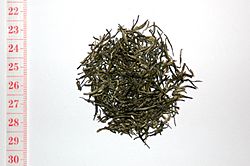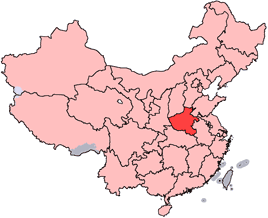Xinyang Maojian tea facts for kids
 |
|
| Type: | Green |
|
|
|
| Other names: | Chinese: 毛尖, Green Tip or Tippy Green |
| Origin: | Henan Province, China |
|
|
|
| Quick description: | A green tea with a sweet taste |
|
|
|
Xinyang Maojian tea is a special type of green tea from Xinyang, a city in Henan Province, China. It's often called one of the most famous teas in China. In fact, it's known as one of the top ten best teas in the whole country!
The name "Xinyang Maojian" tells us two things. "Xinyang" is the city where it's grown. "Maojian" means "hairy tips" in Chinese. This name describes how the tea leaves look. They are small, covered in tiny white hairs, and have pointed tips. This tea was first made by Han tea farmers. Around the early 1900s, the best tea shops in Xinyang officially named this high-quality tea "Xinyang Maojian."
Contents
What Makes Xinyang Maojian Tea Special?
Xinyang Maojian tea is loved for its unique and delicious taste. When you brew it, the tea liquid looks a bit yellowish. It tastes fresh and crisp, and the nice flavor stays in your mouth for a long time.
The Look of the Tea Leaves
The tea leaves are thin and soft. They are covered in many tiny white hairs. They have a dark-green color and are rolled tightly. Both ends of the leaf are pointed, like a tip. Most Xinyang Maojian tea leaves are about 0.5 to 1 inch long. Compared to other famous green teas, Maojian leaves are quite small.
The Wonderful Smell
This tea also has a lovely smell. It has a strong, flowery scent. This comes from natural substances in the leaves. When you brew Maojian tea, its wonderful smell fills the air. It creates a calm and peaceful feeling.
Awards and Recognition
Xinyang Maojian tea has won many awards. In 1915, it won a gold medal at the Panama–Pacific International Exposition in the United States. It won this award alongside a famous Chinese drink called Kweichow Moutai.
In 1990, Xinyang Maojian was tested against other green teas in China. It won first place for its overall quality. Because of its high quality, it is often called the "king of green tea." For many years, Xinyang Maojian has been one of the top three most valuable tea brands in China. In 2017, its brand value was estimated to be 5.991 billion yuan, making it the second most valuable tea brand in China.
History of Xinyang Maojian Tea
Xinyang Maojian is a type of green tea that started in central China. The city of Xinyang in Henan Province is where this tea is grown. The name "mao jian" describes the tea leaves. "Mao" means tiny fuzz, which you might see in your cup. "Jian" means sharp or pointed, referring to the shape of the young leaves.
Tea in Ancient Times
The history of tea in Xinyang goes back over 2300 years! In 1987, archaeologists found tea in an ancient tomb in Gushi County, Xinyang. This showed that tea was being made there as early as 875 BCE.
For the past 100 years, Xinyang Maojian has been known as one of the 10 best teas in China. It is very popular in Henan province. People there enjoy it as a relaxing drink after a busy day.
Famous Tea Shops
In the early 1900s, there were eight famous tea shops in Xinyang that helped make this tea popular:
- Yuanzhen Tea (started 1903)
- Longtan Tea (started 1903)
- Hongji/Cheyun Tea (started 1910)
- Yushen Tea (started 1911)
- Guangyi Tea (started 1912)
- Wanshou Tea (started 1913)
- Guangsheng Tea (started 1915)
- Bohou Tea (started 1919)
In 1914, Longtan Tea and other shops sent their teas to the 1915 Panama–Pacific International Exposition. They won a gold medal there. Over time, most of these tea shops closed. But Longtan Tea survived and grew into a large company called Henan Xinyang Maojian Group.
How the Tea Became Famous
In the early 1900s, people in Xinyang wanted to make their tea even better. They traveled to places like Hangzhou in Zhejiang province to buy tea seeds. They also learned special ways to fry tea leaves, like the methods used for Longjing tea. They took this knowledge and improved their own tea-making process. In 1913, they created "The Mountain Tippy" tea, which was later renamed "Xinyang Maojian." This new tea quickly became famous.
Where Xinyang Maojian Tea Grows
Xinyang is in the southern part of Henan Province. It has a perfect climate for growing tea trees. The tea trees are planted high up in the mountains. The weather changes clearly with the four seasons.
The Perfect Environment
Many tall mountains, like Mt. Cheyun, Mt. Jiyun, and Mt. Tianyun, surround Xinyang. These mountains help keep the air moist and humid. The area has lots of forests, clouds, and rain. There's also a big difference in temperature between day and night. All these natural conditions help the soil stay healthy and rich. This allows the tea trees to absorb good things from the soil, which helps them produce high-quality green tea.
The soil in the Xinyang mountains is mostly yellow and black sandy soil. It's deep, loose, and has a lot of good nutrients. Tea farmers usually choose to grow tea on high mountains, between 500 to 800 meters (about 1600 to 2600 feet) high. The air here is humid, and the sun is not too strong. This means the tea tree buds grow slowly. This slow growth makes the leaves very tender and full, with more good substances inside.
Harvesting the Tea Leaves
Xinyang Maojian tea is harvested in spring and fall. However, the very best tea comes from leaves picked in mid-April. Chinese people call this "Yu Qian Tea." This means the tea is picked before a special time in spring called 'Grain Rain' (Guyu). These early leaves are rare and very fresh, so they cost two or three times more than tea picked later in the season. To make about 500 grams (about 1 pound) of finished tea, you need around 50,000 tiny tea buds!
In ancient Chinese history, there was a very specific rule for picking Maojian leaves. It said that only girls aged 15 to 16 should pick the tea. They had to bathe and change their clothes first. The tea shoots were picked using their mouths and placed into special pouches hanging on their chests.
Main Types of Xinyang Maojian Tea
Local people classify Xinyang Maojian tea based on when the fresh leaves are picked. They call them spring tea, summer tea, and autumn tea.
Spring Tea
This tea is generally picked before the end of May. After the tea trees rest all winter, the spring tea shoots are strong and the leaves are soft and tender. They have many tiny hairs. Spring tea has the most good substances and is the best quality tea of the whole year. Spring tea is further divided into:
- Mingqian Tea: This tea is picked before the Ching Ming Festival (around April 5th). These are the first buds that appear in spring. They are very tender and have a light, delicate scent. Because they grow slowly, almost all of these are the highest quality Xinyang Maojian tea.
- Yuqian Tea: This tea is picked before Gu Yu (around April 20th). The spring weather is mild, and there's plenty of rain. The tea leaves grow well, forming one bud and one leaf. This tea is almost as good as Mingqian tea, but its taste is a bit stronger.
- Chunwei Tea: This tea is picked before the end of spring (around the end of May). The leaves are not quite as perfect as the earlier spring teas, but they still brew well and are more affordable. Many local people drink this type of spring tea every day.
Summer Tea
Summer tea is picked from late June to July. As the weather gets hotter, the tea grows very quickly. The leaves have fewer good substances and more bitter ones. So, summer tea tastes a bit bitter, and its smell is not as strong as spring tea. The leaves are also bigger. However, summer tea can be brewed many times, and it is inexpensive.
Autumn Tea
Tea picked after August is called autumn tea, or sometimes "white dew tea." By autumn, the tea trees have already been harvested in spring and summer. The new leaves have fewer substances, look a bit yellowish, and vary in size. Their taste and smell are not as strong. But autumn tea is not as tender as spring tea, and not as bitter as summer tea. It has its own unique sweet and fragrant smell.


